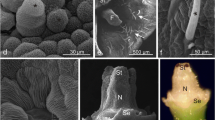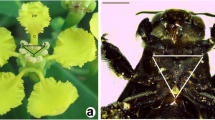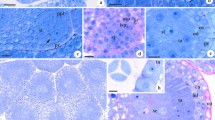Abstract
Heteranthery has been largely associated with a division of labour between anthers. Most species of Stigmaphyllon (Malpighiaceae) present heteromorphic anthers and glandular connectives of different development; yet, the functional meaning of this condition has never been explored in the genus. The aims of this study were to provide a comparative description of the structure and development of anthers and their connective glands in S. bonariense and S. jatrophifolium and to assess the existence of division of functions. Natural populations were selected to collect flowers at different stages. Anthers were subjected to morpho-anatomical, histochemical and pollen viability studies. For both species, abundance of pollen grains and size of anther and their connective glands were estimated. Three types of stamens are recognized: stamen with small, intermediate and large anthers. Anthers of both species exhibit a similar glandular tissue in the connective, and the histochemical analysis revealed that it produce a mucilagous secretion. The pattern of anther wall development, stainability and release of pollen grains was identical among anther types. For both species, we observed a positive relationship between anther size and abundance of pollen grains, but an inverse relationship between area of anthers and size (area and thickness) of connective glands in small anthers vs. intermediate and large ones. Our results evidence a specialization of anthers related to division of labour between heteromorphic stamens in two species of Stigmaphyllon. Thus, one set of anthers produces large amount of pollen grains for pollination and another sets large quantities of mucilage, which would improve pollen transport (better adherence to pollinator body and dampness maintenance). Nevertheless, heteranthery in both Stigmaphyllon species would represent a transitional state towards the division of labour rather than a stable state.










Similar content being viewed by others
References
Acevedo-Rodríguez P (1993) Systematics of Serjania (Sapindaceae). Part I: a revision of Serjania sect. Platycoccus. Mem New York Bot Gard 67:1–93
Ainsworth C (2000) Boys and girls come out to play: the biology of dioecious plants. Ann Bot 86:211–221
Aliscioni SS, Torretta JP (2017) Malpighiaceae. In: Zuloaga FO, Belgrano MJ (eds) Flora Argentina, vol 17. Sigma, Buenos Aires, pp 163–205
Aliscioni SS, Gotelli M, Torretta JP (2018) Structure of the stigma and style of Callaeum psilophyllum (Malpighiaceae) and its relation with potential pollinators. Protoplasma 255:1433–1442
Almeida RF, Mamede MCH (2016) Sinopse de Malpighiaceae no Estado do Espírito Santo, Brasil: Stigmaphyllon. A. Juss. Hoehnea 43:601–633
Anderson WR (1979) Floral conservatism in Neotropical Malpighiaceae. Biotropica 11:219–223
Anderson WR (1981) Malpighiaceae: the botany of Guayana Highland. Part XI. Mem New York Bot Gard 32:21–305
Anderson C (1982) A monograph of the genus Peixotoa (Malpighiaceae). Contr Univ Michigan Herb 15:1–92
Anderson C (1986) Novelties in Stigmaphyllon (Malpighiaceae). Syst Bot 11:120–130
Anderson WR (1990) The origin of the Malpighiaceae-the evidence from morphology. Mem New York Bot Gard 64:210–224
Anderson CE (1997) Monograph of Stigmaphyllon (Malpighiaceae). Syst Bot Monogr 51:1–313
Anderson CE (2011) Revision of Ryssopterys and transfer to Stigmaphyllon (Malpighiaceae). Blumea 56:73–104
Anderson WR, Anderson C, Davis CC (2006) Malpighiaceae. http://herbarium.lsa.umich.edu/malpigh/index.html [January 2019]
Barônio GJ, Maciel AA, Oliveira AC, Kobal RO, Meireles DA, Brito VL, Rech AR (2016) Plantas, polinizadores e algumas articulações da biologia da polinização com a teoria ecológica. Rodriguésia 67:275–293
Barrett SC (2010) Darwin’s legacy: the forms, function and sexual diversity of flowers. Philos Trans R Soc Lond Ser B Biol Sci 365:351–368
Barrios D, Flores J, González-Torres LR, Palmarola A (2015) The role of mucilage in the germination of Leptocereus scopulophilus (Cactaceae) seeds from Pan de Matanzas, Cuba. Botany 93:251–255
Bhandari NN (1984) The microsporangium. In: Jhori BM (ed) Embriology of angiosperms. Springer-Verlag, Berlin, pp 53–121
Buchmann SL (1983) Buzz pollination in angiosperms. In: Jones CE, Little RJ (eds) Handbook of experimental pollination biology. Van Nostrand Reinhold, New York
Buchmann SL (1987) The ecology of oil flowers and their bees. Annu Rev Ecol Evol Syst 18:343–369
Budar F, Pelletier G (2001) Male sterility in plants: occurrence, determinism, significance and use. C R Acad Sci 324:543–550
Collin CL, Shykoff JA (2003) Outcrossing rates in the gynomonoecious-gynodioecious species Dianthus sylvestris (Caryophyllaceae). Am J Bot 90:579–585
D'Ambrogio de Argüeso A (1986) Manual de técnicas en histología vegetal. Hemisferio Sur S.A, Buenos Aires
David R, Carde JP (1964) Coloration différentielle des pseudophylles de Pinmaritime au moyen du réactif de Nadi. C R Acad Sci 258:1338–1340
Davis G (1966) Systematic embryology of the angiosperms. Wiley, New York
Davis CC, Anderson WR (2010) A complete generic phylogeny of Malpighiaceae inferred from nucleotide sequence data and morphology. Am J Bot 97:2031–2048
Davis CC, Anderson WR, Donoghue MJ (2001) Phylogeny of Malpighiaceae: evidence from chloroplast ndhF and trnL-F nucleotide sequences. Am J Bot 88:1830–1846
Davis CC, Schaefer H, Xi Z, Baum DA, Donoghue MJ, Harmone LJ (2014) Long-term morphological stasis maintained by a plant–pollinator mutualism. Proc Natl Acad Sci U S A 111:5914–5919
Dulberger R (1981) The floral biology of Cassia didymobotrya and Cassia auriculata (Caesalpiniaceae). Am J Bot 68:1350–1360
Ferrucci MS, Anzótegui LM (1993) El polen de Paullinieae (Sapindaceae). Bonplandia 6:211–243
Forbes HO (1882) Two kinds of stamens with different functions in the same flower. Nature 26:386
Gates B (1982) Banisteriopsis, Diplopterys (Malpighiaceae). In: Flora Neotropica Monograph, vol 30. Hafner, New York, pp 1–237
Geber MA (1985) The relationship of plant size to self-pollination in Mertensia ciliata. Ecology 66:762–772
Goldberg RB, Beals TP, Sanders PM (1993) Anther development: basic principles and practical applications. Plant Cell 5:1217–1229
Gonzalez AM, Cristóbal CL (1997) Anatomía y ontogenia de semillas de Helicteres lhotzkyana (Sterculiaceae). Bonplandia 9:287–294
González VV, Solís SM, Ferrucci MS (2017) Embryological studies of Magonia pubescens (Dodonaeaeae, Sapindaceae): development of male and female gametophytes in both floral morphs and its phylogenetic implications. Aust Syst Bot 30:279–289
Gottsberger G (1986) Some pollination strategies in Neotropical savannas an forest. Pl Syst Evol 152:29–45
Harder LD (1990) Pollen removal by bumble bees and its implications for pollen dispersal. Ecology 71:1110–1125
Harder LD, Barrett SC (1995) Mating cost of large floral displays in hermaphrodite plants. Nature 373:512
Hrycan WC, Davis AR (2005) Comparative structure and pollen production of the stamens and pollinator-deceptive staminodes of Commelina coelestis and C. dianthifolia (Commelinaceae). Ann Bot 95:1113–1130
Hufford LD, Endress P (1989) The diversity of anther structures and dehiscence patterns among Hamamelididae. Bot J Linn Soc 99:301–346
Johansen DA (1940) Plant Microtechnique. McGraw-Hill BooK Co, New York
Johri BM, Ambegaokar KB, Srivastava PS (1992) Comparative embriology of angiosperms, vol 1. Springer–Verlag, Berlin, pp 1–614
Kaul ML (2012) Male sterility in higher plants, vol 10. Springer Science & Business Media
Klinkhamer PG, de Jong TJ (1993) Attractiveness to pollinators: a plant's dilemma. Oikos 66:180–184
Luo ZL, Gu L, Zhang DX (2009) Intrafloral differentiation of stamens in heterantherous flowers. J Syst Evol 47:43–56
Luque R, Sousa HC, Kraus JE (1996) Métodos de coloração de Roeser (1972) modificado-E Kropp (1972), visando a substituição do Azul de Astra por Azul de Alcião 8GS ou 8GX. Acta Bot Bras 10:199–212
Michener CD (2007) The bees of the world, 2nd edn. The Johns Hopkins University Press, Baltimore
Miyashita RK, Nakasone HY, Lamoureux CH (1964) Reproductive morphology of acerola (Malpighia glabra L.). University of Hawaii. Hawaii Agricultural Experiment Station 63:1–31
Múlgura de Romero ME (2005) Malpighiaceae. In: Burkart AE, Bacigalupo NM (eds) Flora Ilustrada de Entre Ríos (Argentina): dicotiledóneas arquiclamídeas. Geraniales a Umbeliflorales, Instituto Nacional de Tecnología Agropecuaria, Secretaría de Agricultura, Ganadería, Pesca y Alimentos, Buenos Aires, pp 71–86
Müller H (1881) Two kinds of stamens with different functions in the same flower. Nature 24:307–308
Müller H (1882) Two kinds of stamens with different functions in the same flower. Nature 26:30
Müller F (1883) Two kinds of stamens with different functions in the same flower. Nature 27:364–365
Neff JL, Simpson BB (1981) Oil-collecting structures in the Anthophoridae (Hymenoptera): morphology function and use in systematics. J Kansas Entomol Soc 54:95–123
O’Brien TP, McCully ME (1981) The study of plant structure principles and selected methods. Termarcarphi Pty. Ltd., Melbourne
Pacini E, Franchi GG, Hesse M (1985) The tapetum: its form, function, and possible phylogeny in Embryophyta. Pl Syst Evol 149:155–185
Paulino JV, Mansano VF, Teixeira SP (2013) Elucidating the unusual floral features of Swartzia dipetala (Fabaceae). Bot J Linn Soc 173:303–320
Paulino JV, Mansano VF, Prenner G (2016) Evidence for division of labor and division of function related to the pollen release in Papilionoideae (Leguminosae) with a heteromorphic androecium. Int J Bot 177:590–607
Possobom CCF, Guimaraes E, Machado SR (2015) Structure and secretion mechanisms of floral glands in Diplopterys pubipetala (Malpighiaceae), a neotropical species. Flora 211:26–39
R Core Team (2013) R: a language and environment for statistical computing. (R Foundation for Statistical Computing: Vienna, Austria) Available at: http://www.r-project.org
Radford AE, Dickison WC, Massey JR, Bell CR (1974) Vascular plant systematics. Harper & Row Publishers, New York
Rego MMC, Albuquerque PMC (1989) Comportamento das abelhas visitantes de múrice, Byrsonima crassifolia (L.) Kunth, Malpighiaceae. Bol Mus Para Emílio Goeldi Série Zoologia 5:179–193
Reis MG, Faria AD, Alves-dos-Santos I, Amaral MCE, Marsaioli AJ (2007) Byrsonic acid—the clue to floral mimicry involving oil-producing flowers and oil-collecting bees. J Chem Ecol 33:1421–1429
Renner SS, Schaefer H (2010) The evolution and loss of oil-offering flowers: new insights from dated phylogenies for angiosperms and bees. Philos Trans R Soc Lond Ser B Biol Sci 365:423–435
Rodríguez-Riaño T, Ortega-Olivencia A, Devesa JA (1999) Types of androecium in the Fabaceae of SW Europe. Ann Bot 83:109–116
Sazima M, Sazima I (1989) Oil-gathering bees visit flowers of eglandular morphs of the oil-producing Malpighiaceae. Bot Acta 102:106–111
Schneider CA, Rasband WS, Eliceiri KW (2012) NIH image to ImageJ: 25 years of image analysis. Nat Methods 9:671–675
Scott RJ, Spielman M, Dickinson HG (2004) Stamen structure and function. Plant Cell 16:46–60
Siddiqui SA (1968) The microsporangium and the male gametophyte in Malpighia coccigera Linn. Beitr Biol Pflanzen 44:361–364
Sigrist MR, Sazima M (2004) Pollination and reproductive biology of twelve species of Neotropical Malpighiaceae: stigma morphology and its implications for the breeding system. Ann Bot 94:33–41
Simpson BB, Neff JL (1981) Floral rewards: alternatives to pollen and nectar. Ann Missouri Bot Gard 68:301–322
Singh B (1959) Studies in the Malpighiaceae I. morphology of Thryallis glauca Kuntze. Hort Adv 3:1–19
Smith CA, Evenson WE (1978) Energy distribution in reproductive structures of Amaryllis. Am J Bot 65:714–716
Solís SM, Galati B, Ferrucci MS (2010) Microsporogenesis and microgametogenesis of Cardiospermum grandiflorum and Urvillea chacoensis (Sapindaceae, Paullinieae). Aust J Bot 58:597–604
Steiner KE (1985) Functional dioicism in the Malpighiaceae: Spachea membranacea Cuatr. Am J Bot 72:1537–1543
Stern WL, Curry KJ, Whitten WM (1986) Staining fragrance glands in orchid flowers. Bull Torrey Bot Club 113:288–297
Teixeira LAG, Machado IC (2000) Sistema de polinização e reprodução de Byrsonima sericea DC (Malpighiaceae). Acta Bot Bras 14:347–357
Torretta JP, Aliscioni SS, González-Arzac A, Avalos AA (2017) Is the variation of floral elaiophore size in two species of Stigmaphyllon (Malpighiaceae) dependent on interaction with pollinators? Plant Ecol Divers 10:403–418
Vallejo-Marín M, Manson JS, Thomson JD, Barrett SC (2009) Division of labour within flowers: heteranthery, a floral strategy to reconcile contrasting pollen fates. J Evol Biol 22:828–839
Vallejo-Marín M, Silva EM, Sargent RD, Barrett SC (2010) Trait correlates and functional significance of heteranthery in flowering plants. New Phytol 188:418–425
Velloso MSC, Brito VLG, Caetano APS, Romero R (2018) Anther specializations related to the division of labor in Microlicia cordata (Spreng.) Cham. (Melastomataceae). Acta Bot Bras 32:349–358
Vinson SB, Frankie GW, Williams HJ (1996) Chemical ecology of bees of the genus Centris (Hymenoptera: Apidae). Fla Entomol 79:109–129
Vogel S (1974) Ölblumen und ölsammelndeBienen. Trop Subtrop Pflanzenwelt 7:1–267
Vogel S (1990) History of the Malpighiaceae in the light of pollination ecology. Mem New York Bot Gard 55:130–142
Westerkamp CH (1996) Pollen in bee-flower relations some considerations on melittophily. Botanica Acta 109:325–332
Zarlavsky GE (2014) Histología Vegetal: técnicas simples y complejas. Sociedad Argentina de Botánica, Buenos Aires
Zini ML, Galati GB, Solís SM, Ferrucci MS (2012) Anther structure and pollen development in Melicoccus lepidopetalus (Sapindaceae): an evolutionary approach to dioecyin the family. Flora 207:712–720
Acknowledgments
We thank H. J. Marrero for his support on statistical analysis, N. A. Ramirez for helping with the statistical figures and S. S. Aliscioni for the constructive comments on our work.
Author information
Authors and Affiliations
Contributions
All the authors contributed to the study conception and design. Material preparation, data collection and analysis were performed by Adan Alberto Avalos. The first draft of the manuscript was written by Adan Alberto Avalos, and all the authors commented on previous versions of the manuscript. All the authors read and approved the final manuscript.
Funding information
This work was supported by the Consejo Nacional de Investigaciones Científicas y Técnicas (PIP N° 11220170100429C) and the Universidad Nacional del Nordeste (PI N° 15-A002), Argentina.
Corresponding author
Ethics declarations
Conflict of interest
The authors declare that they have no conflict of interest.
Additional information
Handling Editor: Dorota Kwiatkowska
Publisher’s note
Springer Nature remains neutral with regard to jurisdictional claims in published maps and institutional affiliations.
Rights and permissions
About this article
Cite this article
Avalos, A.A., Pablo, T.J., Lattar, E.C. et al. Structure and development of anthers and connective glands in two species of Stigmaphyllon (Malpighiaceae): are heteromorphic anthers related to division of labour?. Protoplasma 257, 1165–1181 (2020). https://doi.org/10.1007/s00709-020-01497-x
Received:
Accepted:
Published:
Issue Date:
DOI: https://doi.org/10.1007/s00709-020-01497-x




